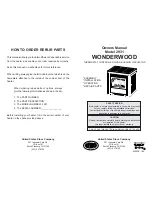
www.desatech.com
113084-01A
6
Unusually Tight Construction
The air that leaks around doors and windows may
provide enough fresh air for combustion and ven-
tilation. However, in buildings of unusually tight
construction, you must provide additional fresh air.
Unusually tight construction is defined as
construction where:
a. walls and ceilings exposed to the out-
side atmosphere have a continuous
water vapor retarder with a rating of
one perm (6 x 10
-11
kg per pa-sec-m
2
)
or less with openings gasketed or
sealed and
b. weather stripping has been added on
openable windows and doors and
c. caulking or sealants are applied to ar-
eas such as joints around window and
door frames, between sole plates and
floors, between wall-ceiling joints, be-
tween wall panels, at penetrations for
plumbing, electrical, and gas lines, and
at other openings.
If your home meets all of these three crite-
ria, you must provide additional fresh air.
See
Ventilation Air From Outdoors, page 7.
If your home does not meet all of the three
criteria above, proceed to
Determining
Fresh-Air Flow For Fireplace Location,
column 2.
Confined and Unconfined Space
The National Fuel Gas Code, ANSI Z223.1/NFPA
54 defines a confined space as a space whose vol-
ume is less than 50 cubic feet per 1,000 Btu per
hour (4.8 m
3
per kw) of the aggregate input rating
of all appliances installed in that space and an un-
confined space as a space whose volume is not less
than 50 cubic feet per 1,000 Btu per hour (4.8 m
3
per kw) of the aggregate input rating of all appli-
ances installed in that space. Rooms communicat-
ing directly with the space in which the appliances
are installed*, through openings not furnished with
doors, are considered a part of the unconfined space.
* Adjoining rooms are communicating only if there
are doorless passageways or ventilation grills be-
tween them.
AIR FOR COMBUSTION
AND VENTILATION
Continued
DETERMINING FRESH-AIR FLOW
FOR HEATER LOCATION
Determining if You Have a Confined or
Unconfined Space
Use this work sheet to determine if you have a
confined or unconfined space.
Space:
Includes the room in which you will install
fireplace plus any adjoining rooms with doorless pas-
sageways or ventilation grills between the rooms.
1.
Determine the volume of the space (length x
width x height).
Length x Width x Height =__________cu. ft.
(volume of space)
Example:
Space size 20 ft. (length) x 16 ft.
(width) x 8 ft. (ceiling height) = 2560 cu. ft. (vol-
ume of space)
If additional ventilation to adjoining room is sup-
plied with grills or openings, add the volume of
these rooms to the total volume of the space.
2.
Multiply the space volume by 20 to determine
the maximum Btu/Hr the space can support.
__________ (volume of space) x 20 = (Maxi-
mum Btu/Hr the space can support)
Example:
2560 cu. ft. (volume of space) x 20 =
51,200 (maximum Btu/Hr the space can support)
3.
Add the Btu/Hr of all fuel burning appliances in
the space.
Vent-free fireplace
__________ Btu/Hr
Gas water heater*
__________ Btu/Hr
Gas furnace
__________ Btu/Hr
Vented gas heater
__________ Btu/Hr
Gas fireplace logs
__________ Btu/Hr
Other gas appliances* + __________ Btu/Hr
Total = __________ Btu/Hr
* Do not include direct-vent gas appliances. Di-
rect-vent draws combustion air from the outdoors
and vents to the outdoors.
Example:
Gas water heater
______________ Btu/Hr
Vent-free fireplace ______________ Btu/Hr
Total
______________ Btu/Hr
4.
Compare the maximum Btu/Hr the space can
support with the actual amount of Btu/Hr used.
________ Btu/Hr (maximum the space can support)
________ Btu/Hr (actual amount of Btu/Hr used)
Example:
51,200 Btu/Hr (maximum the space
can support)
70,000 Btu/Hr (actual amount of
Btu/Hr used)
The space in the above example is a confined space
because the actual Btu/Hr used is more than the maxi-
mum Btu/Hr the space can support. You must pro-
vide additional fresh air. Your options are as follows:
40,000
+ 30,000
= 70,000







































